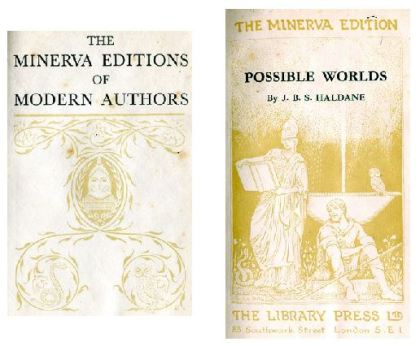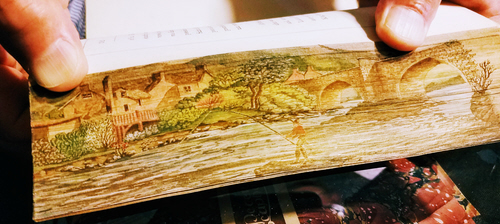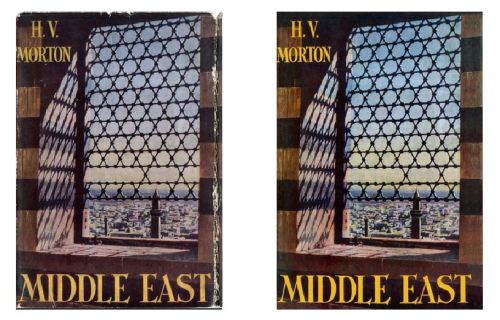
Anyone with an interest in HV Morton who has spent even a short time in second-hand-book shops or browsing their web-sites will have come across the so-called Minerva Editions of his works, with their distinctive faux-leather bindings and gold-leaf trim. The origins of these special editions are somewhat of a mystery although thanks to the interest of one or two Mortonites who specialise in collecting them and several HVM Society bulletins over the years we now know a bit more than we did. With apologies in advance for length, I thought it would be helpful to set out what is known about them.

Sulis Minerva, the Romano-Celtic fusion of Minerva with her British counterpart, Sulis, currently residing in the English city of Bath.
Minerva, described by Ovid as ‘goddess of a thousand works’, was the Roman goddess of wisdom and science aswell as war, art and poetry. Her Greek counterpart was Athena and she is generally depicted carrying a spear and shield and wearing a golden breastplate. Her symbols were the owl, the snake and the olive tree.
So, as names go, Minerva is a pretty good choice if you are in the book publishing business, evoking an image of strength, wisdom and learned studiousness and generally lending an air of gravitas to your product.
This means unfortunately there is a confusing plethora of Minerva publishing houses to be found. From producing copious amounts of gothic horror by women authors in 1790, to odious racist propaganda in 1888, up to present day textbooks relating to Middle Eastern language and culture, and magazines which cover diverse subjects from ancient art and archaeology to Ipswich Lifestyle and Solihull Living, dozens of different Minervas have and still do exist which have nothing to do with our Morton collecion yet persist in popping up during searches of the internet to confuse the armchair researcher.
The Morton Minervas:

An unusual promotional copy (courtesy of JB)
Until recently there was little explanation as to who had actually produced the Morton Minervas. Examination of the individual volumes themselves gives no clue since, apart from their distinctive livery, between the covers they are simply rebound copies of standard editions.
Now, however, thanks to the vigilance of Mortonite JB, we have discovered two unusual sales and promotional copies with fold-out sections, depicting the spines of many of the books in the collection. These have really cast a light on things and we now know the Morton volumes were issued by the Library Press of 36 Russell Square, London, WC 1.
In addition we have the Library Press’s own description of them as being bound in ‘special leather-cloth’, each volume measuring 7 ¾ inches by 5, with an initial price of £2.2s.0d, later amended (by hand on the promotional copies) to £3.10s.6d.
These copies are fascinating in themselves and give a real flavour of the times. They extol the merits of Morton’s words and reveal the personal touch of their original owner who has carefully updated details of prices and the number of titles in the series as they changed.
As an exercise for myself I transcribed some of the ‘sales patter’, and it’s pretty florid stuff, to say the least!
‘The smell of English Meadows
‘As a final effort to convey to the reader the exceptional quality and enduring charm of these remarkable books, permit us to quote from the Author’s own note to the Ninth Edition of “In Search of England”:
‘“If you find in these pages the smell of English meadows, if they bring back to you the smooth movement of English rivers, the stately somnolence of cathedral cities and the sound of bells among elm trees on cool summer mornings I am happy because–well; the pain will not really hurt you. You may even enjoy it.”
‘For ourselves we are sure you will revel in each one of these entrancing volumes. There is nothing to choose between them. Each is as humorous, as full of information, as crammed with little-known legends and facts, anecdotes and wayfaring “characters” as its companion volumes. No book-lover will be content with less than the set of four [amended by hand to five, Ed.] delightful volumes.
‘The Illustrations
‘Each book (except “In Search of England” which has 18) has 16 plates delightfully depicting the country through which the author passes, or the people he meets. “The Call of England” has 8 plates in colour. Each book has an interesting end-paper map, specially drawn by A. E. Taylor, showing the route covered in the book.’
They are all hardback, with embossed brown boards, gilt lettering and upper edge paper and featuring a single, central motif on the front cover, also in gilt, depicting a tree, possibly the deity’s olive tree. Initially issued as a series of four, the number of titles grew and there are now at least nine that we know of:

The full set (with a duplicate): “In Search of England”; “The Call of England”; “In Search of Scotland”; “In Scotland Again”; “In Search of Ireland”; “In Search of Wales”; “A London Year”; “In The Steps of St Paul” and “In the Steps of the Master” (courtesy of OH)
The earliest edition we know of is dated 1931, the latest is 1936. [Editor’s note – with grateful thanks to VW, reader of this blog and inhabitant of Dolgellau (Dolgelley), Wales, we now know of a Minerva edition of “In Search of Wales” which dates to 1938)]
Slightly earlier, during the 1920s and 1930s, the Library Press also published another series, known as the Minerva Editions of Modern Authors. These are similar, but by no means identical to the Morton editions.
Like the Morton editions, many (but not all) Minerva Editions of Modern Authors also have leather-like covers with gilt lettering and a central solitary motif on the front cover. The details however are quite distinct. The front cover motif varies from author to author but none of the Editions of Modern Authors to be found on the websites of second-hand book dealers depict the olive tree of Minerva found on the Morton volumes. Furthermore they are markedly smaller than the Morton editions, measuring approximately 6 ¾ inches by 4 ¾ and, most importantly, the opening pages (at least of the copies I posess – AA Milne’s “Once a Week” and “Possible Worlds” by JBS Haldane) declare them quite clearly to be Minerva Editions of Modern Authors, which the Morton Minervas do not.

A Morton Minerva next to two Minerva Editions of Modern Authors, roughly to scale, showing the size difference.

The initial pages from the Minerva Editions of Modern Authors clearly announcing their origins.
Authors in the Minerva Editions of Modern Authors include:
Hilaire Belloc, AA Milne, JB Priestley, EV Knox, John Masefield, EV Lucas, RH Mottram, Arnold Bennett, J. B. S. Haldane and Aldous Huxley all of whose works were presented in brown leatherette boards with a central Minerva bust in gilt and green.
In a variation on this theme AA Milne, EV Lucas and Arnold Bennet also had editions with brown leatherette boards but with a central hexagonal motif in gilt and blue containing their initials. GK Chesterton was published with marbled blue boards and a central hexagonal motif containing his initials, GKC. Hilaire Belloc also had his works produced in blue and in black boards, both with a simple central rectangular motif containing the initials HB.

Details of the central motifs on the front covers – the Morton olive tree is on the left, followed by AA Milne’s initials and the bust of Minerva from my copy of “Possible Worlds” by JBS Haldane. Note the use of colour in the motifs from the Modern Authors editions which is absent from the Morton editions.
In conclusion, what we know so far is the intriguing HV Morton Minerva Editions were (at least) nine in number and possibly a later addition to or sub-set of a similar, yet quite distinct and wider ranging series known as the Minerva Editions of Modern Authors. They were presumably co-editions of Morton’s works, marketed in conjunction with their original publishers as striking and collectible matching sets in the 1930s and issued by the (now non-existent) Library Press of Russell Square, London in the same way, for example, the Folio Society does today. They seem not to have been new editions or reprints but were simply specially re-bound versions of existing editions.
If anyone reading this has any information which might cast further light on the matter I would be most grateful if they would like to get in touch either by leaving a comment at the bottom of the article or via the email link here.
My grateful thanks go to JB, SB, JB, OH, JH and RM.
With best wishes,
Niall Taylor, Glastonbury, England,






 Yeomen with the Royal Maundy, Westminster Abbey
Yeomen with the Royal Maundy, Westminster Abbey ‘There’s not many of us stick lighters left… but here and there a few of us still muster for the evening’
‘There’s not many of us stick lighters left… but here and there a few of us still muster for the evening’













